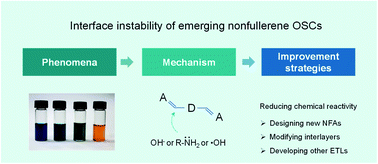On the interface reactions and stability of nonfullerene organic solar cells
Abstract
Long-term stability is critical for organic solar cells (OSCs) for practical applications. Several factors affect the stability of OSCs, including materials stability, morphology stability of bulk-heterojunctions and interface stability. In this perspective, we focus on interface stability due to interfacial reactions between the emerging acceptor–donor–acceptor (A–D–A) type nonfullerene active layers and interfacial layers. The description covers the initial phenomena of interfacial instability, mechanism of interfacial reactions, and strategies adopted to suppress interfacial reactions between the nonfullerene active layers and interfacial layers. Methods to test and analyze the chemical instability of nonfullerene acceptors are also included. The C![[double bond, length as m-dash]](https://www.rsc.org/images/entities/char_e001.gif) C vinyl linker between the donor moiety and acceptor moiety is chemically or photochemically reactive and is a weak point for interface stability. The interface stability of OSCs could be enhanced by reducing the reactivity of the C
C vinyl linker between the donor moiety and acceptor moiety is chemically or photochemically reactive and is a weak point for interface stability. The interface stability of OSCs could be enhanced by reducing the reactivity of the C![[double bond, length as m-dash]](https://www.rsc.org/images/entities/char_e001.gif) C vinyl linker or removing it directly, modifying the surface of interfacial layers, and developing other novel interfacial materials.
C vinyl linker or removing it directly, modifying the surface of interfacial layers, and developing other novel interfacial materials.

- This article is part of the themed collections: Most popular 2022 materials and energy articles, In celebration of Chinese New Year and 2022 Chemical Science Perspective & Review Collection


 Please wait while we load your content...
Please wait while we load your content...